Alan Lacy has produced an excellent film on the endangered Mexican gray wolf. You can lean more about him and his efforts here.
The Mexican gray wolf is making a come back, but due to its genetics it now faces extinction once again. One wolf faces a daring operation as we question whether man and wolves really live along side each other. One Page Description | PDF Promo flier | Connect with Alan Lacy on facebook
Synopsis – In the American Southwest, a unique species of wolf unlike any other is making a comeback. Once extinct in the wild, the little known Mexican gray wolf has slowly pulled back from the very brink—against all odds. From a founding population of just seven animals, this critically endangered species now faces a new threat from within: its own genetics. As part of a bold recovery mission, one lone wolf is given a chance to offer new hope for the survival of her species. But can there be a balanced and sustainable future where ranchers, conservationists, locals, and biologists alike can coexist with
this apex predator?
PBS Nature Host/Narrator Chris Morgan narrates this remarkable story that’s never been told before, as the Mexican wolf celebrates 20 years of recovery since their initial release into the wild in 1998. It’s truly an American conservation story in the making.
The Producer – Alan Lacy is an award winning filmmaker who is passionate about the natural world His fascination with the critically endangered Mexican gray wolf, and his desire to do something to help, spurred him on to produce his first film about the endangered species. Since those beginnings in 2011, Alan has tracked the Mexican gray wolf from a captive breeding program through release into the wild, and brought his love of photography and storytelling to document the efforts of men and women dedicated to restoring these magnificent apex predators to their natural habitat.
Alan has been enthralled with wildlife since childhood, and worked to make the world a better place for both nature and man. Coming from a background in aviation and business, he adapted his skills to the world of wildlife filmmaking, and simultaneously fell in love with it. His first film, “Gray Area: Wolves of the Southwest” is an award winning documentary that has screened internationally. Now, he has set his sights even higher with his next wildlife film, currently in development. Alan lives in the Phoenix area and can often be found exploring wild regions of the southwest.
The Director – Born in England, Dean Cannon grew up in the Sonora Desert of Arizona. At an early age, Dean found a passion for flying and photography and finally traveled to Africa at 26 to work on a project for NTT Japan. There he found his calling and filled a position working for Animal Planet in Bangkok, Thailand. Since then, Dean has traveled throughout South East and Eastern Asia and Alaska working for clients such as Animal Planet, Discovery HD, and National Geographic Channel. Working with Alaska Fish and Game, Dean has traveled the entire state filming from the Alaskan Arctic to Brooks Camp in the Southwest. Dean still flies and lives with his wife and daughter in Anchorage, Alaska.
The Wolves – For years wolves have been regarded as fierce and dangerous creatures; ravenous beasts that stalked humans from the shadows. The reality is, wolves rarely attack humans. Wolves are at the bottom of that list. However, based on their successes as a top predator in the ecosystem, people still feel threatened by them. Extirpation campaigns at the turn of the 19th Century and into the 20th Century decimated wolf populations by the tens of thousands. During these times, massive hunts were carried out to eradicate the wolf from the landscape, and thousands of Mexican grays were killed. Their pelts could be seen hanging from many lodges and homesteads across the Southwestern United States.
The Mexican gray wolf was considered effectively extinct in the Southwestern United States by the 1940s. The same actions were taking place in Mexico. Luckily, five wolves were captured in remote regions of the Mexican states of Durango and Chihuahua between 1977 and 1980, quite possibly the last remaining Mexican gray wolves in existence. These five wolves, along with four other wolves found in captivity were the last of their kind. Seven of these wolves would be known as the genetic founders of the population today.
Back From the Brink
The Mexican Wolf Species Survival Plan (a captive breeding program of the Association of Zoos and Aquariums) has brought the Mexican wolf back from the very brink of extinction and played an integral role in the reintroduction of the “lobo.” Holding Facilities across the United States and Mexico are part of the breeding program, which oversees the genetic rescue of the species. Currently, in the wild there are three genetic lineages of wolves that stem back to the original seven founding animals. Inbreeding is a real threat to the success of the recovery program, and new genetically valuable wolves must be introduced to the current wild population to increase genetic diversity in the wild population.
The captive breeding program is working hard to create the needed genetic diversity, however circumstances in the wild threaten to undo decades of hard work in restoring this diversity. Gray Area: Wolves of the Southwest explores this problem and presents ground breaking techniques underway to save the Mexican wolf from the threat of a second extinction.
If you enjoyed this you may life, The U.S. Game and Wildlife Connection
© 2017 - 2024 ASA. All rights reserved. Click here for content usage information.



